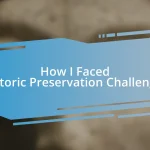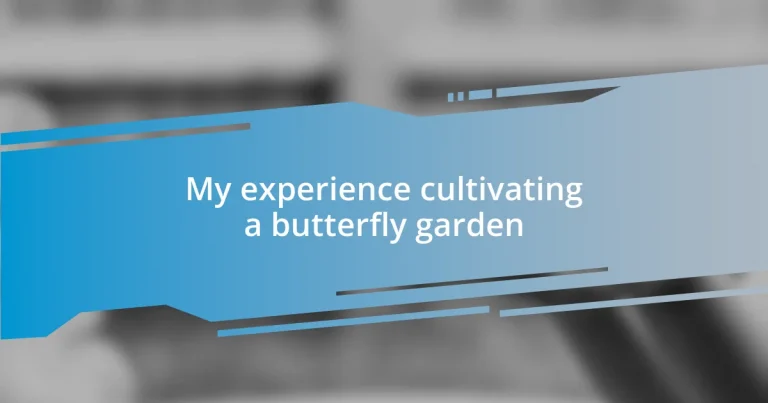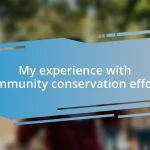Key takeaways:
- Butterfly gardens are vital for supporting ecosystems, providing habitats for both caterpillars and adult butterflies, and serving as educational tools for all ages.
- Choosing the right location and selecting a diverse mix of nectar and host plants are critical for attracting and sustaining butterfly populations.
- Regular maintenance, including deadheading flowers and monitoring for pests, enhances the garden’s vibrancy and ensures a thriving environment for butterflies.
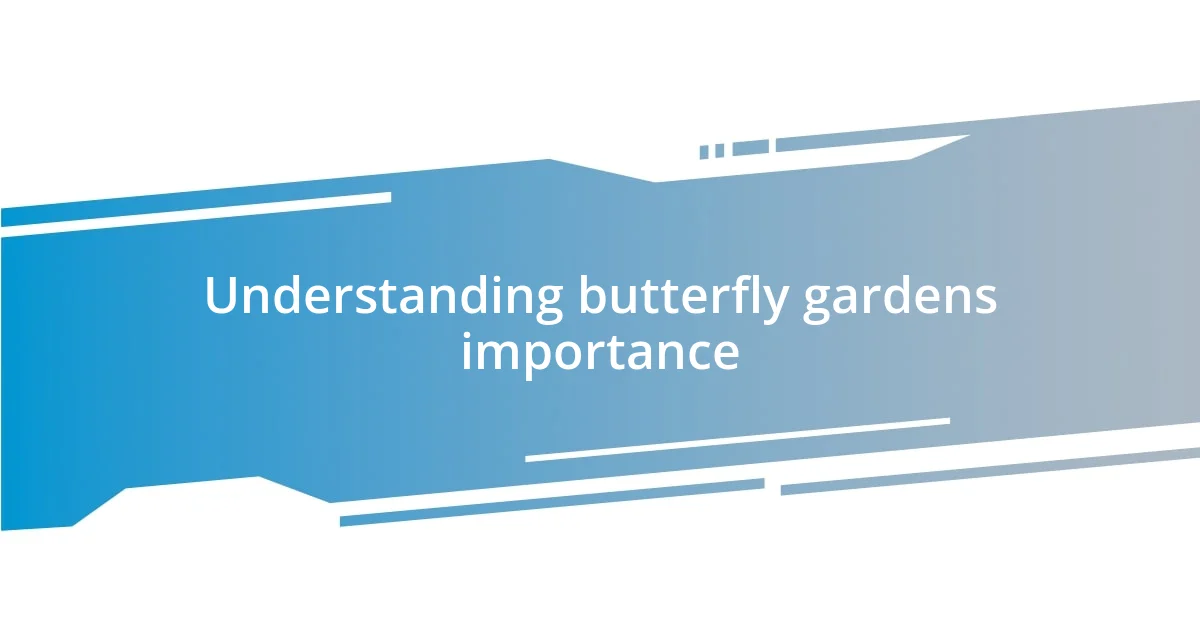
Understanding butterfly gardens importance
Butterfly gardens are essential not only for the beauty they bring but also for the crucial role they play in supporting local ecosystems. I remember the first time I noticed a butterfly landing on a flower in my garden; it felt like a magical moment, emphasizing how our outdoor spaces can contribute to nature’s balance. Have you ever thought about how one garden can become a sanctuary for these delicate creatures?
Creating a butterfly garden can be a truly rewarding experience, providing habitat for both caterpillars and adult butterflies. I felt a swell of pride when I realized that my efforts were not just beautifying my yard but also offering a nurturing space for these fascinating insects to thrive. When you observe a caterpillar munching on a plant you’ve cultivated specifically for it, don’t you feel a sense of connection to nature’s cycle?
Moreover, these gardens serve as educational platforms for all ages. Watching children marvel at butterflies fluttering around is a joy that brings us closer to understanding nature’s wonders. It makes me wonder – if we can engage young minds with such beauty, how can we inspire a greater appreciation for the environment in them? Butterfly gardens foster curiosity and encourage us to learn about biodiversity, all while enriching our lives with their colorful presence.

Choosing the right location
Choosing the right location for your butterfly garden is paramount to its success. I vividly remember my first attempt, where I positioned it in a shaded corner, thinking it would be safe from harsh sunlight. Little did I know, butterflies are drawn to sunny spots where they can bask in the warmth. It was a humbling moment, but it taught me how crucial location is in attracting these lovely visitors.
When selecting a site, consider these key factors:
- Sunlight: Aim for at least 6 hours of direct sunlight daily.
- Wind Protection: A sheltered area can help protect butterflies from strong winds that might deter them.
- Water Source: Ensure there’s a nearby water source to support their hydration needs.
- Plant Variety: Choose a location where you can diversify the types of plants for both nectar and host plants.
- Visibility: Personally, I find joy in observing my garden while sipping morning coffee, so choosing a spot that’s visible from your home enhances the experience.
Finding the right spot can transform your garden into a bustling hub of activity and bring daily delight.

Selecting suitable plants for butterflies
Selecting the right plants for your butterfly garden is a delightful challenge that can truly bring these enchanting creatures to your space. I remember eagerly researching local native plants that attract butterflies. It was exciting to discover that many butterflies have specific preferences for certain flowers. For instance, milkweed is vital for monarchs, while zinnias are a favorite for a variety of species. Each time I included a new plant, I felt a thrill, picturing the butterflies that would soon visit my garden.
In my experience, it’s crucial to create a blend of nectar plants and host plants. Nectar plants provide food for adult butterflies, while host plants are necessary for caterpillars. I learned the hard way that if you only focus on nectar sources, you might attract butterflies but won’t support the entire life cycle. It’s heartwarming to see butterflies flitting about, and equally rewarding to find caterpillars munching away on their favorite leaves.
Let’s look at how different plants support butterflies based on their roles. Here’s a quick comparison:
| Plant Type | Examples |
|---|---|
| Nectar Plants | Lavender, Echinacea, Butterfly Bush |
| Host Plants | Milkweed, Parsley, Fennel |
Choosing a mix ensures your garden stands as a thriving haven for butterflies, giving you countless moments of joy and connection with nature.
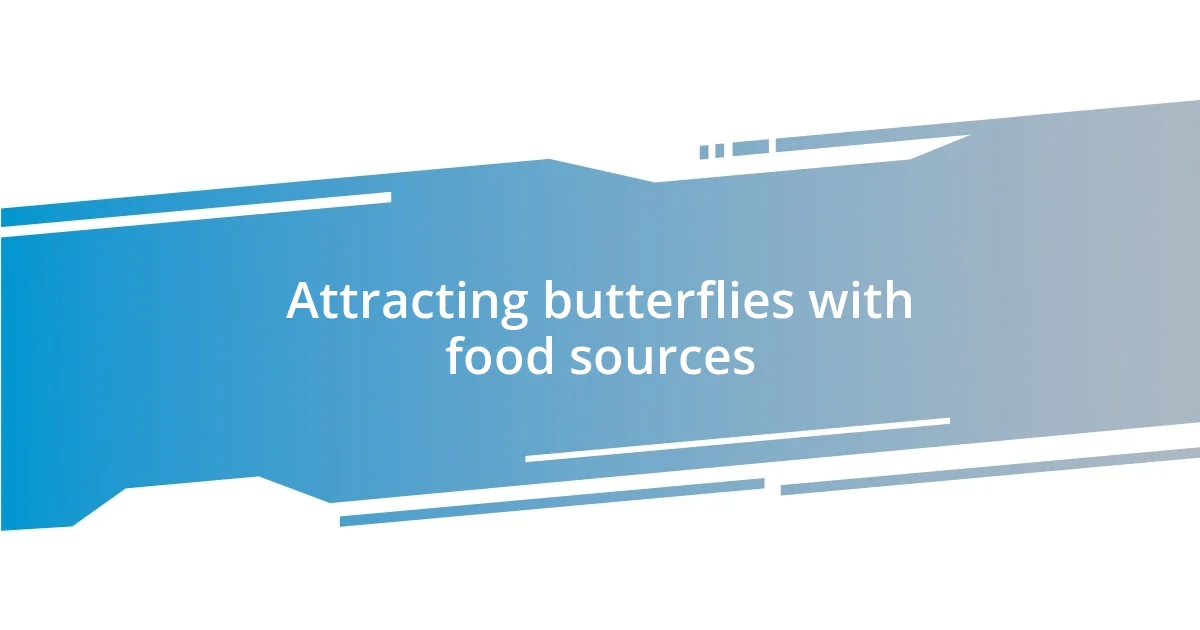
Attracting butterflies with food sources
Attracting butterflies with the right food sources is a delightful aspect of cultivating a butterfly garden. I remember the sheer joy I felt when I first witnessed butterflies hovering around the vibrant blossoms of my nectar-rich plants. It was almost like having a party in my garden! I quickly learned that certain flowers are irresistible to butterflies, such as coneflowers and butterfly bush. Each flower I added seemed to bring in a new wave of fluttering visitors, and it made me realize how much they depend on these food sources.
Nectar is vital for adult butterflies, so diversifying the plants in your garden is essential. I’ve experimented with a variety of species, and I was thrilled to see how different butterflies gravitated toward specific blooms. Watching a swallowtail land gracefully on my zinnias was a magical moment that filled me with a sense of gratitude for this natural connection. Have you ever thought about how butterflies brighten up a garden and also rely on it for survival?
Don’t forget to include some larval host plants to ensure a steady butterfly population. I made the mistake of overlooking this at first, focusing only on nectar plants. Once I added milkweed, I noticed a rise in monarch activity. It was gratifying to see those caterpillars growing, knowing that I contributed to building a thriving ecosystem. It’s not just about attracting them; it’s about playing a part in their life cycle.
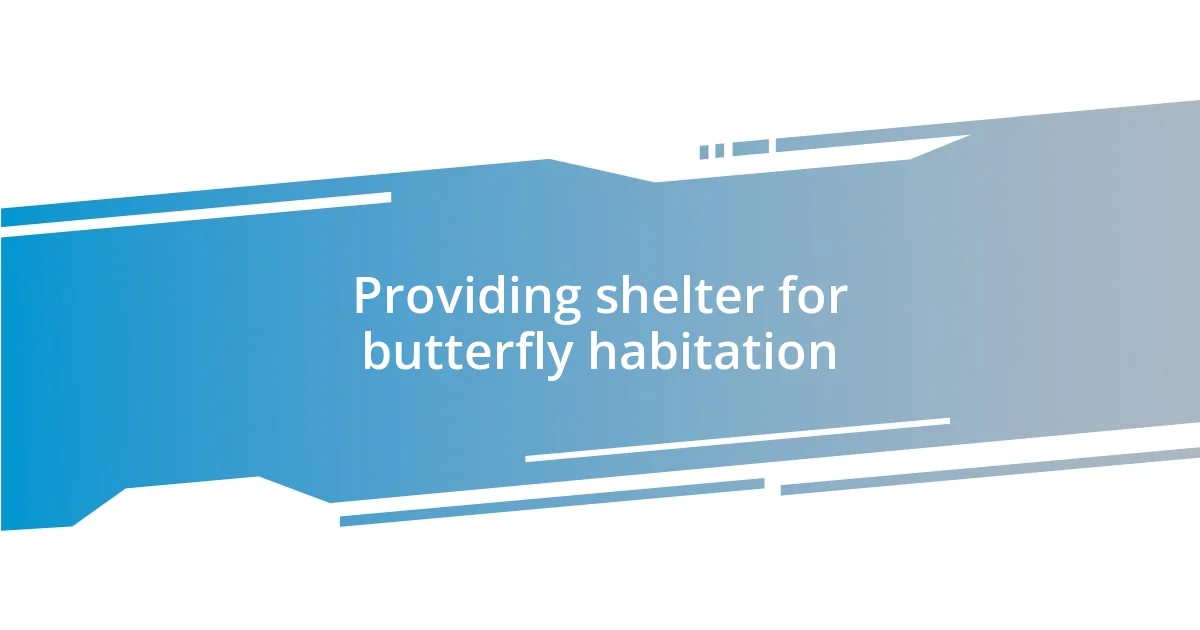
Providing shelter for butterfly habitation
Providing shelter for butterflies is another vital aspect of creating a welcoming environment in your garden. I recall stashing away a few small piles of twigs and branches in the corners of my yard, thinking they might just contribute to the rustic charm. To my surprise, these natural shelters became cozy nooks for butterflies to rest and hide from predators. Have you ever noticed how a simple pile of leaves can transform into a haven for these delicate creatures?
Additionally, dense shrubs and flowering plants can also serve as protective spaces. I found that adding a few bushy plants not only offered cover but also created a mini ecosystem for butterflies to thrive. Each time I saw a butterfly nestled among the leaves, it filled me with joy, knowing I had provided a safe retreat for them. Isn’t it fascinating how a little planning can go such a long way in supporting these beautiful guests?
Moreover, I embraced the idea of including certain features like small water sources or rocks for sunbathing. During warm days, I often spotted butterflies basking on flat stones, soaking up the sun’s rays. This simple addition made my garden even more inviting. Reflecting on these moments, I’m reminded of the interconnections in nature; when I create a home for butterflies, I also create a sanctuary for myself in the process.
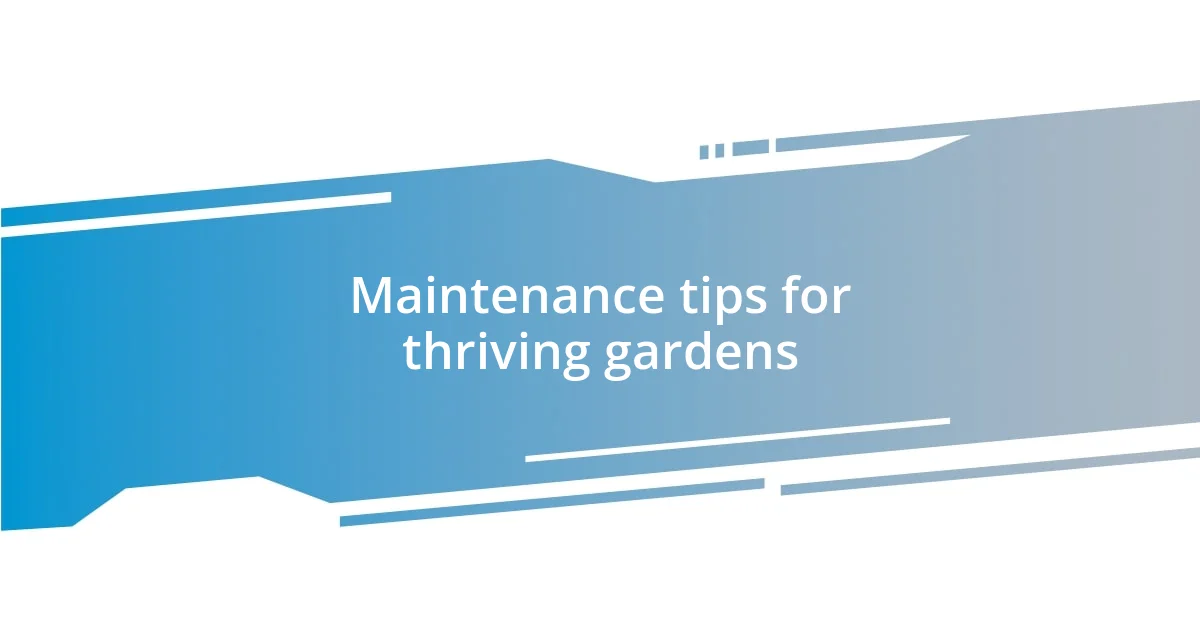
Maintenance tips for thriving gardens
Keeping a butterfly garden thriving requires regular care and attention. One of my go-to maintenance tips is deadheading flowers as they fade. I remember the first time I did this, I was amazed at how quickly new blooms emerged, enticing even more butterflies to visit. Have you ever watched your garden transform overnight with a few simple snips? It’s like giving your plants a refreshing makeover.
Another key aspect is watering your garden appropriately. Initially, I struggled with overwatering, thinking that more was better. When I switched to a deeper but less frequent watering schedule, I noticed my plants flourished, and the butterflies seemed much happier. I can’t tell you how satisfying it feels to see them flutter about, thriving in a well-maintained habitat.
Lastly, I recommend observing your garden regularly for pests and diseases. I recall a time when aphids attacked my prized milkweed, and I acted quickly by introducing beneficial insects like ladybugs. It was a thrill to see nature’s balance restored, knowing that I had played an active role in maintaining my garden’s health. What maintenance strategies have you found effective in keeping your garden vibrant and inviting?
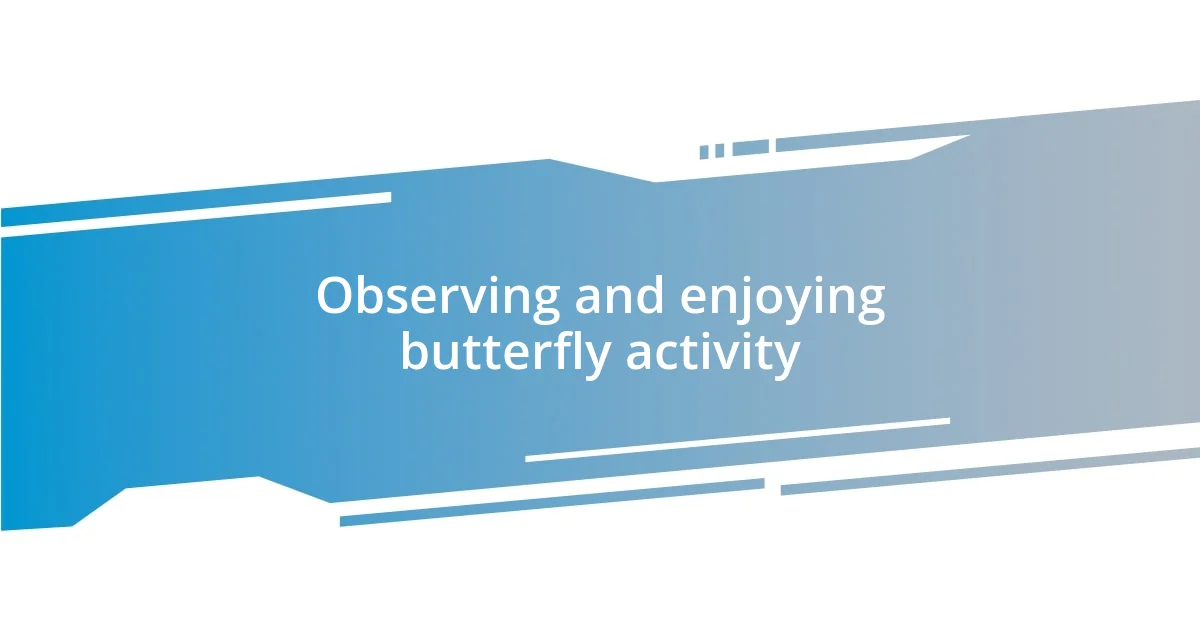
Observing and enjoying butterfly activity
Watching butterflies in my garden is like witnessing a dance of colors and life. I recall a sunny afternoon when I settled on my garden bench, a cup of tea in hand, and observed a swirl of butterflies flitting from flower to flower. It struck me how mesmerizing their movements were, each flutter as if they were showcasing their beauty just for me. Have you ever taken a moment to really watch them? The way they interact with the blooms is nothing short of enchanting.
I find immense joy in recognizing the different species that visit my garden. Each one has a unique personality; some are daring, while others are shy. I remember spotting a Monarch butterfly for the first time, tracing its golden orange patterns as it drifted gracefully past. The moment felt almost magical, and it left me wondering about its journey from caterpillar to this stunning creature. Aren’t we all fascinated by how such transformations happen in nature?
Engagement goes beyond mere observation; I often keep a journal detailing my butterfly encounters. Jotting down the dates and species I see has deepened my appreciation for their cycles and habits. One day, I noted that certain flowers attracted specific butterflies more effectively. Experiencing their presence while making these observations cultivates a sense of connection, reminding me of the intricate web of life we all share. What stories have you gathered from your own garden explorations?











